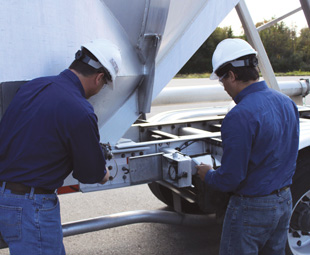Inspect the unexpected

Regular 30-minute inspections of the vehicles in your fleet will lower your maintenance costs and reduce unnecessary and costly roadside breakdowns.
Most of the truck manufacturers that are marketing heavy commercial vehicles in South Africa today have extended the service intervals of the vehicles they sell. In long-distance operations, service intervals have been extended to 30 000 km and on some vehicles to 40 000 km!
These extended service intervals are good for the operators as this allows them to maximise vehicle uptime and reduce servicing costs. But a vehicle should be inspected regularly between the service dates to ensure that it is in a good mechanical and safe operating condition.
During a regular inspection, the technician will be able to detect any tell-tale signs of a pending failure that could result in a roadside breakdown and a costly repair. The technician will also have the opportunity to grease the vehicle – especially the propshaft and suspension – plus attend to any small problem that needs attention.
The inspection should be systematically done using a well-designed inspection sheet that covers all the major items to be checked.
The inspection should cover the following components of the vehicle;
Vehicle Identification
• Current vehicle licence disc
• Current operator’s disc
• Front and rear number plates
• Data plate
Cab
• Cabs need to be inspected for any accident damage
• The operation of all lights and indicators
• Windscreen and windscreen washer operation
• Wiper blades
• Mirrors
• Hooter
• Sun visors and pedal rubbers
• Entrance step
Chassis
• Inspection of chassis for any cracks or damage
• Fuel tank properly secured and not leaking
• Body mountings
• Springs and suspension
• Load sensing valve and ABS connections
• Fifth wheel and trailer coupling need to be inspected and the fifth wheel must be greased
Brakes and Clutch
• The entire brake system needs to be carefully checked
• Brake lining/brake pad wear
• All brake retarders
• The clutch operation including free play
Steering
• Power steering must be checked
for oil leaks and the steering for
excessive play
• Entire steering mechanism
Wheels and Rims
• Tyre pressures
• Condition of all the tyres on the vehicle
• Wheel alignment
• Inner tyre valve extensions must be in place and properly secured
• Wheel rims and fastening systems
Engine
• Excessive smoke, oil leaks and fluid levels
• Tell-tale signs of pending engine
problem that could lead to a roadside breakdown
• Fan belts and pulleys
• Engine air intake system
Exhaust System
• Leaks and exhaust securement
Cooling System
• Check for leaks
• The cleanliness of the radiator core
• The correct ratio of anti-freeze
Batteries
• General condition of the batteries including the terminals
• Water level
• Battery box and securing clamps
Drive line
• All propshaft couplings and centre bearing to be checked
• The propshaft must also be checked for excessive play
Professional heavy-vehicle fleet owners, who have installed the discipline of inspecting their vehicles in between the manufacturer’s recommended service intervals, have found this practice to be highly beneficial.
One of this country’s most respected commercial vehicle industry authorities, VIC OLIVER has been in this industry for 49 years. Before joining the FOCUS team, he spent 15 years with Nissan Diesel (now UD Trucks), 11 years with Busaf and seven years with International.
Published by
Focus on Transport
focusmagsa




